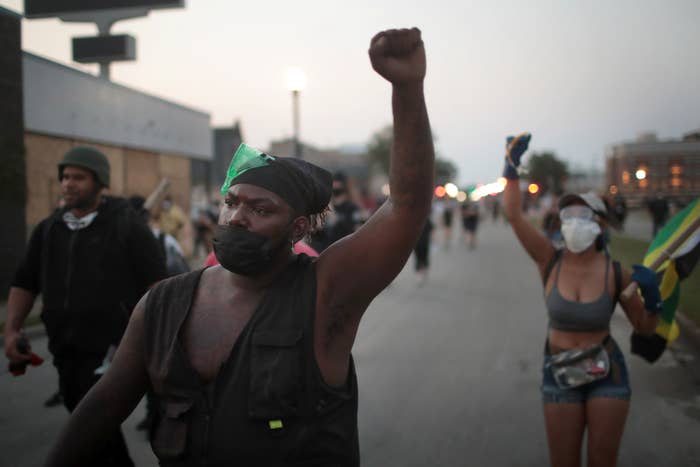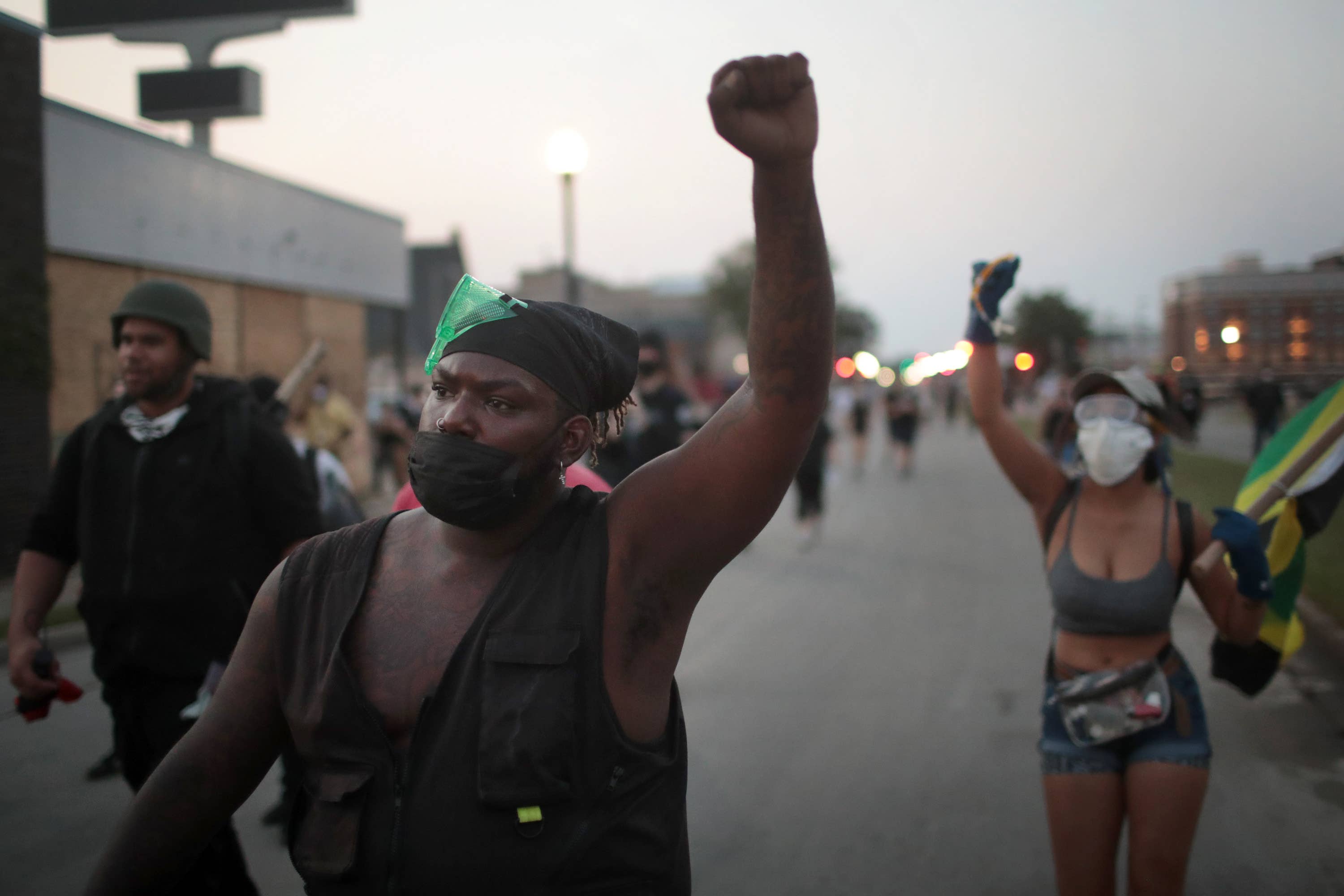
Despite the largest, most sustained, and consistent movement of active protesting in the streets since the civil rights protests, and in spite of the uprisings at city halls, the murals, chants, and cries of Black Lives Matter reverberating across the country and the globes, Black people are still being greeted with death and disdain for their bodies in a major way.
After 29-year-old Jacob Blake, a father of five, was on Sunday, Aug. 23, shot in the back by Officer Rusten Sheskey, the Black Lives Matter movement took post in Kenosha, Wisconsin, and created civil unrest in the name of justice for Blake and his family. The community began to rally around another slain Black body, while forces native to Kenosha rose to display their own show of force in the city.
On the third day of unrest in the city, tensions rose to a fevered pitch at a nearby gas station. A group of men with AR-15-style rifles was said to be “protecting the property” and clashed violently with protesters. Among them in the footage of the shootings was 17-year-old Kyle Rittenhouse, a Blue Lives Matter supporter, who shot and killed two protesters and wounded a third.
After the shooting, Rittenhouse walks past the police, who do not arrest him, in a continued showcase of why the police culture woven into the fabric of America needs to change immediately.
We wanted to filter through the noise and the state-sponsored trauma that continues to be inflicted on the Blake family and Black community, and break down everything you need to know about that chaotic night, the armed terrorist, and the massive response to witnessing the fallout from another Black life being murdered. — Kevin L. Clark
Who is Jacob Blake?
Jacob Blake is a 29-year-old father of three. He hails from Evanston, Illinois, and his family has a lengthy history of community activism in his hometown. His grandfather was the pastor of Ebenezer AME Church in Evanston, and led the fight for fair housing in Evanston in the 1960s.
Blake’s uncle, Justin Blake, told the Chicago Tribune that Blake moved to Kenosha a few years ago for a job, his family, and a safer life. Justin also mentioned that Blake was continuing the family tradition of public service through volunteer work with Black Urban Recycling, a charity that recycles aluminum cans in order to raise money for a community center in Chicago.
Blake had an active arrest warrant related to sexual assault, trespassing, and disorderly conduct, but it’s unclear whether police were aware of this on August 23, when he was shot by a police officer in Kenosha.
A video of the incident shared by Benjamin Crump, the Blake family’s attorney, shows Blake walking away from police officers and attempting to get into the driver’s seat of his SUV. At that point, one of the officers grabs Blake by his shirt and shoots him from behind approximately seven times. Witnesses speculate that Blake was checking on his three young sons when he opened the door.
Blake’s fiancée, Laquisha Booker, told NBC’s Milwaukee affiliate, WTMJ-TV, that police shot him in front of their three children. “That man just literally grabbed him by his shirt and looked the other way and was just shooting him. With the kids in the back screaming. Screaming.”
On Wednesday, August 26, the state Department of Justice identified the police officer who shot Blake as Officer Rusten Sheskey, a seven-year veteran of the Kenosha State Department. Blake’s father told the Chicago Sun-Times that his son has “eight holes” in his body and is paralyzed from the waist down.
What happened at the protest?
In the wake of Blake’s shooting, community members took to the streets of Kenosha to protest police brutality. While protests were initially peaceful, demonstrations became violent as law enforcement clashed with protesters.
On Monday, August 24, the second night of protests in Kenosha in response to Blake’s shooting, multiple buildings were set on fire. The Kenosha Fire Department tallied 37 fires, along with medical services for numerous accidents, assaults, and injuries with traumas of varying degrees, including a shooting.
As protests continued, a white vigilante with a long gun walked down a street in Kenosha, firing his weapon at protesters and killing two men and injuring a third. Police swarmed the area, rushing past the shooter despite the crowd screaming that he was responsible—a stark contrast to the fate of Blake only two days prior. Cell phone footage from that same night shows cops expressing appreciation for the presence of armed white militia members and giving them bottles of water.
Who is Kyle Rittenhouse?
Seventeen-year-old Rittenhouse, a suspect in the shooting, was arrested on August 26 in his hometown of Antioch, Illinois, where he lived in an apartment complex with his mother. He was charged with first-degree murder. Activist Shannon Watts noted that Rittenhouse’s social media profiles were full of misogynistic and white supremacist rhetoric. Before it was deactivated, Rittenhouse’s Facebook page featured consistent praise of law enforcement—including posts honoring officers who died in the line of duty and a picture framed with the “Blue Lives Matter” logo that features him holding a long-arm rifle.
According to the Chicago Tribune, Rittenhouse was affiliated with local police cadet programs, including the Grayslake-Lindenhurst-Hainesville Public Safety Cadet Program, which took down previously shared pictures featuring Rittenhouse participating in program activities on Wednesday.
Footage from a January 2020 Donald Trump rally in Des Moines, Iowa, shows Rittenhouse in the front row. Trump 2020 campaign spokesperson Tim Murtaugh told BuzzFeed News, “President Trump has repeatedly and consistently condemned all forms of violence and believes we must protect all Americans from chaos and lawlessness. This individual had nothing to do with our campaign and we fully support our fantastic law enforcement for their swift action in this case.”
What has been the public reaction so far?
Since the release of the first video showing Blake being shot, many have been vocal about their desire to see justice served, including NBA players such as LeBron James, Donovan Mitchell, and Kyle Kuzma. The championship-contending Milwaukee Bucks, which happen to be the team that is closest to Kenosha, decided to go on strike and sit out Game 5 of their first-round playoff series against the Orlando Magic. (Bucks small forward Sterling Brown has been speaking out against police brutality since he was tased and arrested by Milwaukee police in January 2018.)
Within hours, the Magic also went on strike, followed by the Oklahoma City Thunder, Houston Rockets, Los Angeles Lakers, and Portland Trail Blazers. The NBA subsequently released a statement explaining that all three games scheduled for the night would be postponed and rescheduled for a later date.
Hours later, NBA insider Shams Charania broke the news that the Lakers and Clippers, two of the most preeminent championship contenders, voted to go on strike for the rest of the NBA season. On Thursday, August 27, the New York Times reported that the league would resume playoff games.
While NBA players will return to the court, the unprecedented decision to postpone games was echoed by athletes in other sports. The WNBA, which had most recently taken actions to support innocent prisoners, Ahmaud Arbery, George Floyd, and Breonna Taylor, postponed three scheduled games. The MLB postponed three games. The MLS canceled five of the six games that were due to kick off on Wednesday. Two-time Grand Slam tennis champion Naomi Osaka announced that she would not play her semifinal match in the Western & Southern Open in New York.
Why the events in Kenosha cannot be ignored
While these cancelations and postponements mark a historic moment in the intersection of athletics and activism, the battle for justice and accountability in Kenosha is nowhere near a point of resolution. Awareness, public outcry, and sports game cancelations will ring hollow if no lasting changes are implemented in response. This is not the first time that tense race relations in Kenosha have taken center stage. Kenosha has a history of troubling police-community tensions that dates back to many years before Blake was shot.
Former Kenosha County Board Supervisor Dayvin Hallmon told Time that the tension in Kenosha between the city’s Black population and its police force has been bubbling for decades. He noted several incidents he experienced in which he did not feel that police were concerned with Black people’s safety. He went on to say, “You have this white supremacist contingent in Kenosha, and for some reason, they feel very, very comfortable.”
Kenosha is located at the approximate midway point between Milwaukee and Chicago, two of the most racially segregated cities in the United States. A 2019 Economic Policy Institute report noted that Midwestern states, including Wisconsin, make up 10 of the 11 states “with the largest ratio between Black and white unemployment in 2017.” Additionally, five of the six metropolitan areas in America where Black residents experience concentrated poverty at rates over 40% are in the Midwest.
In 2004, a 21-year-old white resident of Kenosha named Michael Bell, Jr. was shot and killed by police in front of his family. An internal investigation absolved officers of any blame, but Bell’s family later won a lawsuit against the city and helped push for a provision that changed the way that deaths in the state are investigated.
In 2016, Hallmon proposed a reform package for the Kenosha police department, including body cameras for police officers. In 2017, the city unanimously voted to pass a resolution recommending the use of body cameras. The measure has yet to be implemented.
Protesters pushing for police accountability measures such as body cameras and increased transparency in the wake of Blake’s shooting are continuing to press forward in a fight that has been on the minds of many Kenosha residents for years.
As sweeping calls for police accountability continue to spread and 2020 sees what may be the largest protest movement in American history, the consequences of what happens with regard to Officer Sheskey, the Kenosha Police Department, and Kyle Rittenhouse extend far beyond city limits. The Justice Department has opened an investigation into the police shooting of Jacob Blake as protests continue to spike.
To put the size and significance of recent protests into perspective, recent polls indicated that about 15 million to 26 million people participated in demonstrations over the death of George Floyd and others in the weeks after his death. This dwarfs the turnout of protesters to civil rights marches of the 1960s, which numbered in the hundreds of thousands. The massive turnout to protests represents a dramatic shift in public sentiment as it pertains to policing.
Polls show that 57 percent of Americans and 49 percent of white respondents now believe that police are likely to use excessive force against African-Americans, compared to 33 percent of Americans and 26 percent of white respondents in 2014, after Eric Garner was killed. The historic power of police unions in state and local governments continues to weaken in response to shifting public opinion, which has pressured lawmakers to take action. As the world watches what unfolds in Kenosha, policy shifts pertaining to police accountability will reverberate through courtrooms and newsrooms nationwide.

